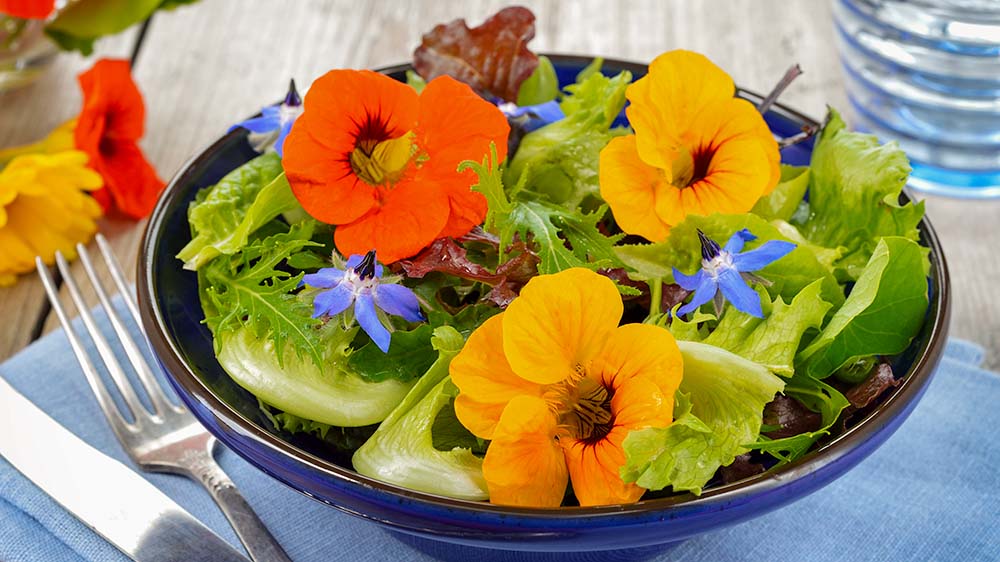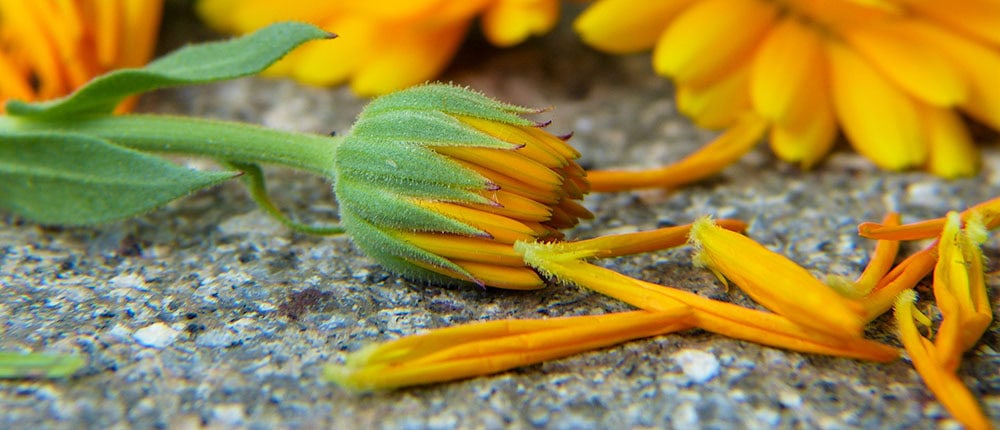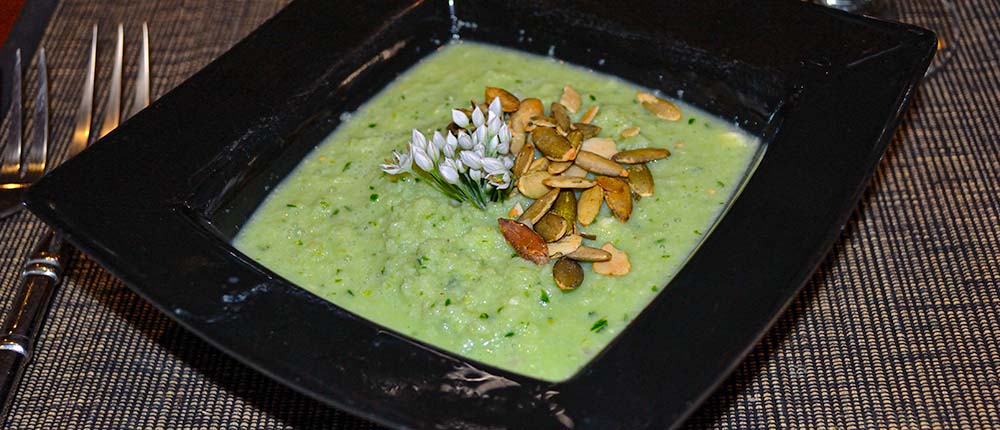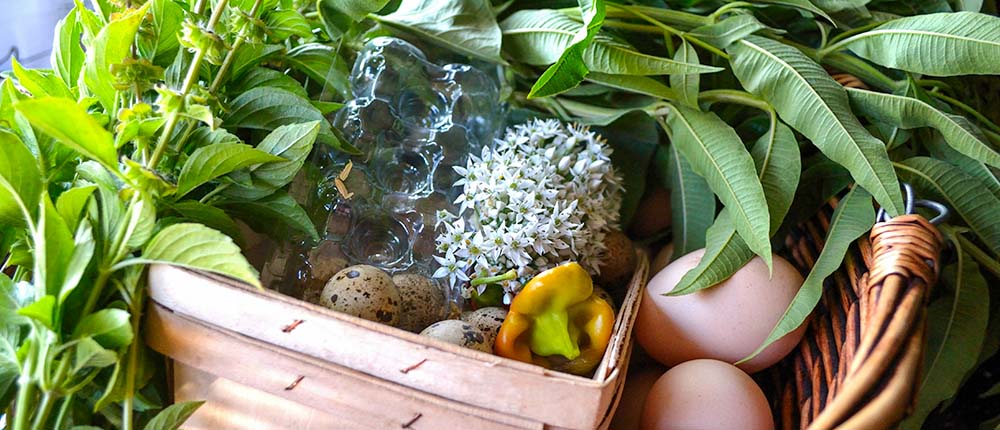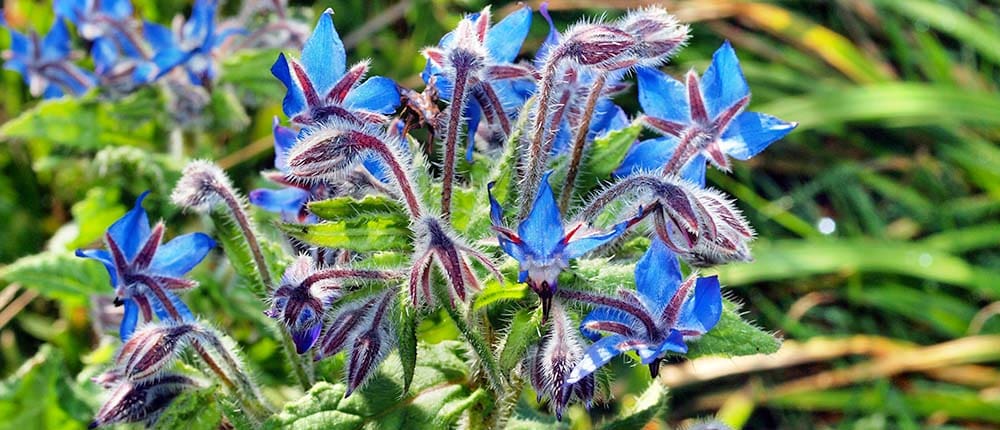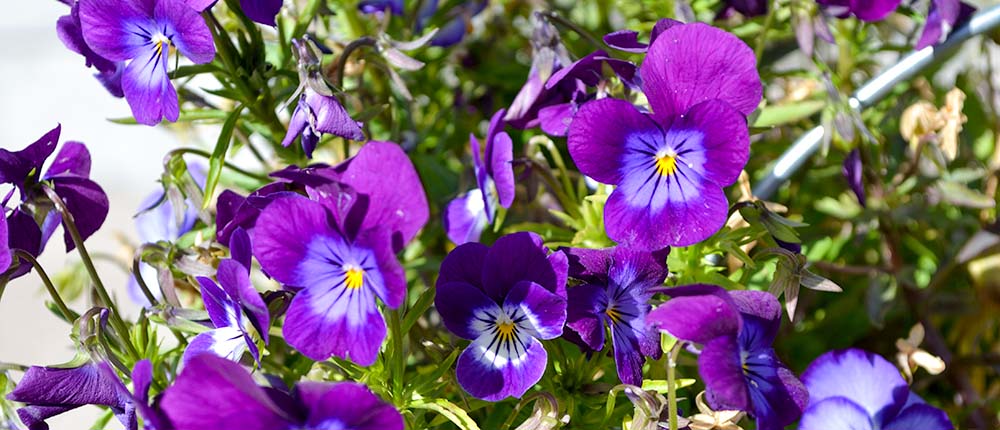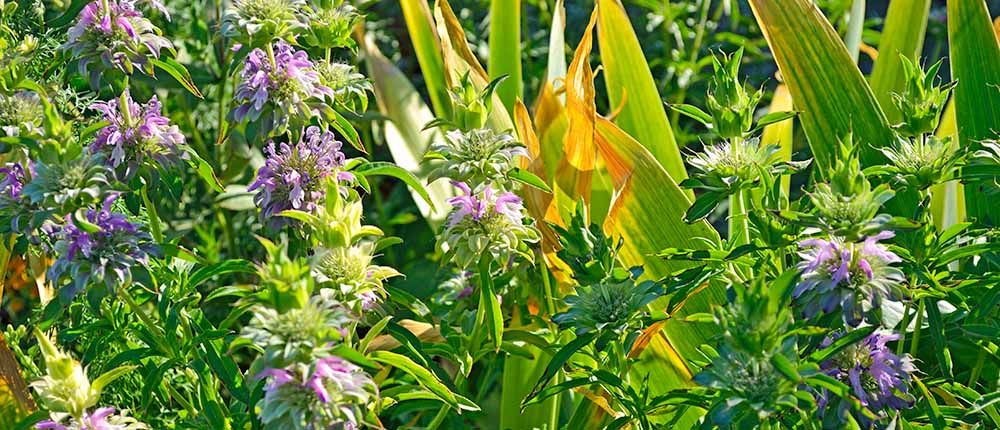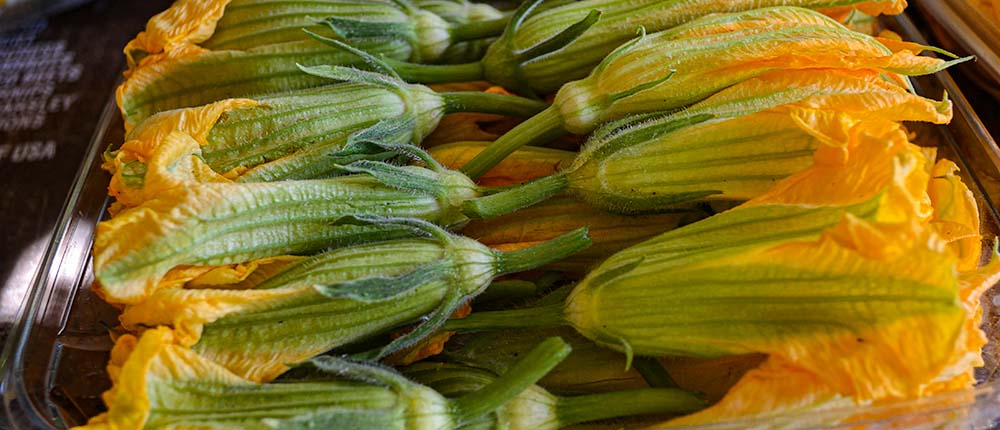Edible Flowers
From Garden to Gourmet – Heirloom Varieties for Every Kitchen
To the Japanese, a dish’s visual appeal and presentation are just as crucial as the food’s taste. When it comes to adding color and flavor to meals, edible fresh flowers are the secret ingredient your kitchen’s been craving. Add those flowers to your cooking—even everyday ones—and you will change how you feel when you sit down to eat. They offer vibrant colors, surprising flavors, and a touch of elegance. Using edible flowers can elevate your kitchen skills in the eyes of your family and friends, giving you the reputation of a “gourmet cook.”
These easy-to-grow beauties thrive in all sorts of gardens – even containers on your balcony! Join us as we explore how to transform your outdoor space into a feast for the eyes and the table.
Can you name a popular edible flower that tastes like cucumber?
How about one that tingles with a hint of mint?
Edible flowers are full of surprises, from vibrant colors to unexpected flavors. Get ready for a flavor adventure that’ll tickle your tastebuds and ignite your imagination.
Freshly harvested calendula or pot marigold bud.
History of Edible Blooms
Edible flowers might seem like a new culinary trend, but their history is as rich and colorful as the blooms themselves. Different cultures worldwide have incorporated edible flowers into their cuisines and traditions for centuries.
The ancient Romans, renowned for their opulent feasts, scattered violets and rose petals over their dishes, adding a touch of luxury and a hint of floral perfume. In ancient China, flowers like chrysanthemum and honeysuckle were treasured for their medicinal properties, often brewed into soothing teas or mixed into healing tonics.
However, the use of edible flowers extended far beyond these two civilizations.
In ancient Egypt, for instance, flowers like chamomile and rose were enjoyed for their beauty and used to flavor dishes and drinks. In India, marigolds are sacred in Hindu culture, adorning garlands and religious offerings while lending their vibrant hues and unique flavors to rice dishes and desserts. The delicate aroma of rose petals and orange blossoms in the Middle East perfumes sweet and savory dishes and refreshing beverages like rosewater.
During the Victorian era, a fascination with the language of flowers swept across Europe, and edible flowers took on new meaning. Candied violets, for instance, became a symbol of love and affection, often gifted as tokens of admiration. Imagine sweet nothings whispered through the delicate petals of a sugared flower!
Chefs and home cooks alike are discovering the unique flavors, vibrant colors, and health benefits these blooms offer. From garnishing a simple salad to infusing a sophisticated cocktail, edible flowers are again taking center stage in our kitchens and gardens.
Cucumber gazpacho with chive flowers and pepitas.
Flowering Edibles
The Perfect Garden Multitaskers
Edible flowers could be the ultimate garden multitaskers, offering a whole lot more than just good looks and tasty flavors. Think of them as the life of the garden party, their vibrant colors and sweet nectar acting as irresistible invitations for beneficial pollinators like bees and butterflies. These hardworking insects are essential for a thriving garden, helping pollinate your fruits, vegetables, and other flowers.
By planting a variety of edible flowers, you’re effectively rolling out the red carpet for these helpful creatures, creating a vibrant garden that benefits all your plants.
Don’t forget the sheer beauty and versatility of edible flowers in making your garden beds into a living work of art. Think of bright orange calendula blossoms peeking through leafy greens or interspersed with delicate chive flowers in your herb garden. You can create edible flower patches full of color and flavor that double as snacks for you and your pollinator friends.
Basket of fresh produce with eggs, basil flowers, and chive blossoms.
Edible Flowers in the Kitchen
Edible flowers are like a painter’s palette, adding rich colors and surprising flavors to your dishes. Scatter a handful of bright calendula petals over a simple salad, their subtle saffron-like notes adding depth to every bite. Or muddle a few fragrant lavender blossoms into a homemade lemonade for a refreshing twist. Try brewing a floral tea with chamomile or calendula blossoms, or mix up a batch of honey-sweetened violet syrup for your next lemonade or iced tea.
And don’t forget about desserts! Candied violets make a stunning decoration for cakes and cookies, while rose petals can be infused into syrups for a touch of floral sweetness.
Edible flowers aren’t just for sweet treats.
With its cooling cucumber-like taste, Borage can be chopped and added to savory dishes like soups and sauces. Peppery nasturtiums, or garlicky chive blossoms, can be stuffed with cheese, tossed into stir-fries, or add a flavorful kick to savory dishes like soups, sauces, and even main courses.
- Borage – Vegetable salads, pastas, dessert decorations, cream cheese spreads, sandwiches
- Calendula – Green salads, soups, pasta, grain bowls, and dessert decoration.
- Chives – Vegetable salads, pasta, herb butter and cream cheese spreads, soups, sandwiches, grains.
- Cilantro – Green salads, pasta and grains, cream cheese spreads, salsas, and sandwiches
- Dianthus – Fruit and vegetable salads, dessert decorations, beverages, honey, herb butter, and cream cheese spreads, and sandwiches.
- Johnny-Jump Up – Fruit and vegetable salads, pasta, dessert decoration, beverages, honey, herb butter, cream cheese spreads, sandwiches, and grains
- Anise Hyssop – Fruit and green salads, dessert decorations, beverages, honey, herb butter, and cream cheese spreads.
- Lemon Bee Balm – Vegetable salads, pasta, soups, grains, dessert decorations, honey, herb butter, cream cheese spreads, and sandwiches.
- Nasturtium – Fruit and vegetable salads, soups and pasta, dessert decorations, beverages, honey, herb butter, cream cheese spreads, sandwiches, and grains.
Borage flowers.
Edible Flower Stories
Some of these edible flowers come with stories as fascinating as their flavors.
Take the borage flower, for example. Roman writer and naturalist Pliny the Elder wrote that the lush borage plant’s star-shaped, baby blue flower drove away melancholy and increased a man’s courage. Roman soldiers often added it to their wine before heading into battle, hoping to channel some of that celestial bravery.
With its sunny yellow and orange petals, Calendula was more than a cheerful sight in medieval gardens. It was a staple in apothecaries, valued for its anti-inflammatory and healing properties. Herbalists would use calendula ointments to soothe irritated skin and promote wound healing, proving that beauty and function can go hand in hand.
And then there’s the lively Johnny Jump-Up, a flower that seems to dance in the breeze. Folklore tells of its use in love potions, its heart-shaped flower petals thought to ignite passion and romance. Some even believed that adding Johnny Jump-Ups to a love potion could make someone fall head over heels!
Johnny Jump-Up flowers.
Growing Your Edible Flower Garden
Ensure you select the right flowers to grow and eat, as not every flower is edible. Check with a reference guide before planting, or simply plant a packet of our Edible Flower Seed Mix. We’ve done the work for you, choosing beautiful and delicious flowers to brighten your garden and dishes!
Planting edible blooms is easy – scatter the seeds on the surface of moist soil, then lightly rake them in and gently water to settle them. Keep the soil moist for the first couple of weeks or until you see seedlings peeking their heads up, then reduce the moisture slightly.
Depending on your climate, you can plant edible flowers from mid-spring until late summer or early fall. In climates with dependable winters, the latest you should plant is about two months before your first expected frost date. In warm or hot climates, you can grow almost all year long.
Lemon bee balm flowers.
Harvesting Edible Flowers
Knowing when and how to harvest your edible flower buds is all about timing and a gentle touch. This is the key to unlocking their full flavor and keeping them fresh.
Generally, the best time to pick is in the morning, after the dew has dried but before the sun gets too intense. This ensures the blossoms are plump with moisture and haven’t lost any of their volatile oils, which contribute to their unique aromas and tastes.
When it comes to harvesting, treat your flowers delicately.
Use a sharp pair of scissors or pruners to snip the stems just below the flower head. This encourages the plant to produce more blooms throughout the season. Handle the petals gently to avoid bruising or crushing them.
If you’re not using your edible flowers immediately, store them in the refrigerator in an airtight container lined with a damp paper towel. This will help keep them fresh for a few days. Some flowers, like nasturtiums and calendula, can even be frozen for later use.
For specific flowers, here are some additional tips:
- Borage: Harvest the young, tender leaves in addition to the flowers.
- Calendula: Pick the petals individually rather than the entire flower head.
- Chives: Snip the entire flower stalk to encourage new growth.
- Cilantro: Harvest flowers before they go to seed for the best flavor.
By following these guidelines, you’ll know that your edible flowers are at their peak of flavor and freshness when you’re ready to use them in your kitchen creations.
Freshly harvested squash blossoms.
Tips for Beginners
Growing edible flowers is easier than you might think! You don’t need a sprawling garden to grow these beauties – a couple of pots on a sunny balcony or a small raised bed can be the perfect starting point. You can begin with a handful of varieties that pique your interest or plant a couple of pinches of a curated edible flower seed mix. As you gain experience and confidence, you can gradually expand your collection and try new varieties.
Gardening should be about having fun and experimenting. Let your creativity bloom alongside your flowers! As you explore the world of edible flowers, you’ll discover that they bring joy to every stage of the gardening journey, from seed to plate.

